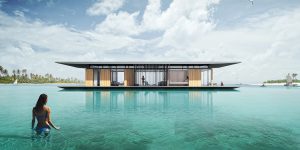Maldives, holiday island destination, sees healthy growth in real-estate market
Despite the growing competition in the tourism sector from the neighbouring countries, the Maldives’ property market is expected to reap benefits from the government’s investment in its key industry

With over 1,000 islands spread across 90,000 square kilometers in the Indian Ocean, white sand beaches and tranquil, crystal clear waters, The Republic of Maldives has long been regarded as one of the best holiday destinations in the world. Over the recent decades, the expansion of high-end tourism in the Maldives has allowed the republic to make tourism the key industry in its economy, with 96.5% of the total GDP coming from the industry, according to HVS Asia Pacific. With the Maldivian government putting a strong emphasis on its public sector investment program to meet the growing visitor demands, the Maldives’ real estate market is expected to remain stable, with the hotel industry to continue to grow in the near to medium-term future.
Dependency on the tourism industry
Tourism, the main economic lifeline in the Maldives, has been paramount to the country’s image and appeal to foreign investors. While generally reliable in the tourism sector, the country’s dependency on the industry has not been without its risks. With the growing popularity of nearby holiday destinations, particularly Sri Lanka as a rising competitor, the length of stays in the Maldives’ hotels and resorts declined by 20% from 2010 to 2014. Moreover, political and economic uncertainty in key global markets — China, Russia, Europe — has negatively impacted growth in tourist arrivals, with records falling short of the government’s target of 1.5 million visitors in 2015, according to the Horwath HTL Special Market Reports Issue 61: Maldives.
Influence of the Chinese market
Although Europe has been historically the main source of tourism-related revenue, the Maldives has grown increasingly dependent on the Chinese market, which in 2015 accounted for almost one-third of total tourist arrivals. However, according to Horwath HTL, the Chinese market figures have been on a downward trend since August 2015, with the trend attributed to the Chinese Yuan devaluation and the slowdown of the Chinese economy. “The Chinese traveller has been the one reason why the true effects of the Global Financial Crisis that hit western countries in 2009 were not felt so badly in the Maldives”, said Mifzal Ahmed, co-founder and vice president of strategy of the Maldives’ largest international airline Mega Maldives in an interview for newspaper Mihaaru in July 2016.
Despite the challenges, the performance of the tourism and hospitality sector has remained resilient showing general improvement in 2016, as compared to 2015. Although coming short of achieving the government’s targeted goal of visitor numbers, Hotelier Maldives reported in the 2016 Maldives Tourism Industry Review that the industry recorded 4.2% tourist arrival growth rate (compared with 2015’s 2.4% growth rate). Strong positive growths were also identified from most European markets following the Eurozone’s mild recovery in 2016, while the tourist numbers from other key markets like India, Sri Lanka, Saudi Arabia and Australia also picked up.
Government investment in infrastructure
In 2016, the government of the Maldives took expansive measures to anticipate the increasing regional competition and cater to the growing demand in the tourism industry, particularly in the area of public infrastructure. Major developments already on the way are the expansion of the country’s international airport and the entry of several new airlines that will improve the accessibility from key markets. Diversification of tourism offerings, such as resorts and new types of attractions, are also expected to bring in new markets into the country. A total of 11 new upscale and luxury resorts are planned for construction by 2018 according to the Ministry of Tourism, with the average daily rate expected to see notable improvement in the second half of 2017 as the new supply in the ultra-luxury segment begins to enter the market.
Scarcity of residential offerings
With hundreds of resort offerings in the Maldives, a residential property for sale remains rare. Development of new properties is not easy as all materials have to be brought in from abroad and many developers are not willing to take the associated risks. With limited residential properties available, the surging demand for housing has spurred several on-going developments, including Hulhumalé, an artificial island built in three phases, with the culmination of Phase I in 2020. The island, catering to a total population of 100,000 once all phases of development are completed, will incorporate commercial, industrial and residential components that will include mid-to-luxury housing and beach bungalows.
This article was written by Olha Romaniuk and first published in Palace 19.









